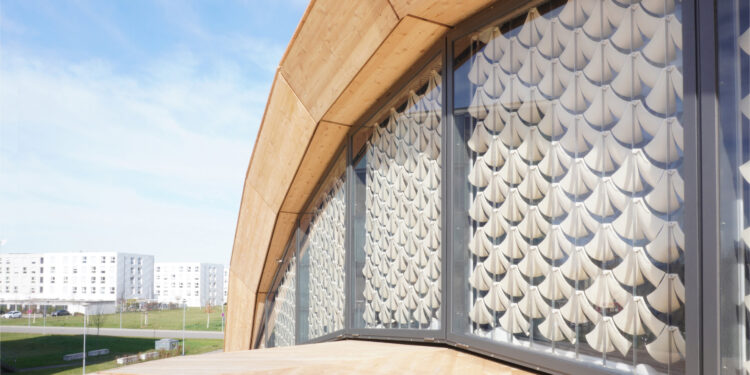The adaptive and self-adjusting shading system “Solar Gate” supports the climate control of buildings. Credit: ICD/IntCDC, University of Stuttgart
Using pine cones as a model, researchers from the Universities of Stuttgart and Freiburg have developed a new energy-independent facade system that passively adapts to bad weather. The review Natural communications published the research results.
“Most attempts at weather responsiveness in architectural facades rely largely on elaborate technical devices. Our research explores how we can harness the responsiveness of the material itself through advanced computational design and additive manufacturing “, explains Professor Achim Menges, director of the Institute of Computer Design. and Construction (ICD) and spokesperson for the Cluster of Excellence Integrative Computational Design and Construction for Architecture (IntCDC) at the University of Stuttgart.
“We are making a shading system that opens and closes autonomously in response to weather changes, without the need for operational energy or mechatronic elements. The biomaterial structure itself is the machine.”
Using bioinspired design, natural materials and widely accessible technologies, researchers from the Universities of Stuttgart and Freiburg have developed the “Solar Gate” facade system, the first adaptive, weather-sensitive shading system that operates without energy electric.
Scientists used the movement mechanisms of pine cones as a model for the Solar Gate, which opens and closes in response to changes in humidity and temperature without consuming metabolic energy. The team successfully reproduced the anisotropic (direction-dependent) structure of cellulose in plant tissues using standard 3D printers.
Biosourced hygromorphic materials and bioinspired 4D printing
Cellulose is a natural, abundant and renewable material that swells and shrinks with variations in humidity. This property, known as hygromorphism, is frequently observed in nature, for example in the opening and closing of the scales of pine cones or the inflorescences of silver thistle. The research team exploited this hygromorphic property by custom manufacturing bio-based cellulose fibers and 4D printing them in a bilayer structure inspired by pine cone scales.
Material systems produced by this additive manufacturing technique called 4D printing can change shape autonomously in response to external stimuli. For the Solar Gate, researchers developed a computational manufacturing method to control the extrusion of cellulosic materials using a standard 3D printer, allowing the self-forming and reversible behavior of the printed material system to be exploited in 4D.
In high humidity, cellulose materials absorb moisture and expand, causing printed elements to curl and open. Conversely, at low humidity, cellulose materials release moisture and contract, causing printed elements to flatten and close.
“Inspired by the hygroscopic movements of pine cone scales and silver thistle bracts, Solar Gate has managed to translate not only the high functionality and robustness of biological models into a bio-inspired shading system, but also the aesthetics of plant movements This can be considered the “royal road of bionics”, because everything that fascinates us in biological concept generators has also been realized in the bio-inspired architectural product,” says Professor Thomas. Speck, plant manager of Biomechanics Group Freiburg and spokesperson for the Cluster of Excellence Living, Adaptive and Energy-Autonomous Materials Systems (livMatS) at the University of Freiburg.
Using bioinspired 4D printing and bio-based cellulose materials, the research team developed an adaptive shading system that responds to daily and seasonal weather changes. Credit: ICD/IntCDC, University of Stuttgart
Architectural integration of self-forming elements
The research team tested the functionality and durability of the bioinspired adaptive shading system in real weather conditions for over a year. The Solar Gate was then installed on the livMatS Biomimetic Shell, a demonstration building of the IntCDC Cluster of Excellence and the livMatS Cluster of Excellence, which serves as a research building at the University of Fribourg.
The shading system was installed on its south-facing skylight, which helps regulate the building’s interior climate. In winter, the 4D printed shading elements open to let in sunlight and provide natural heating. In summer they close to minimize solar radiation. Powered solely by daily and seasonal weather cycles, this adaptive process operates without any electrical power.
The Solar Gate thus represents an energy-independent and resource-saving alternative to conventional shading systems. Since buildings account for a significant portion of global carbon emissions due to the typically high energy required to maintain indoor comfort, reducing the energy needed for heating, cooling and ventilation is of great importance. importance.
The Solar Gate highlights the potential of accessible and cost-effective technologies such as additive manufacturing and shows how cellulose, as an abundant and renewable material, can contribute to sustainable architectural solutions.
More information:
Tiffany Cheng et al, Adaptive shading adapted to weather conditions using bio-based and bio-inspired hygromorphic 4D printing, Natural communications (2024). DOI: 10.1038/s41467-024-54808-8
Provided by the University of Stuttgart
Quote: Self-adjusting shading system mimics pine cones for energy-independent weather response (January 14, 2025) retrieved January 14, 2025 from
This document is subject to copyright. Except for fair use for private study or research purposes, no part may be reproduced without written permission. The content is provided for informational purposes only.



